Multi-Epoch Optical Spectroscopy Variability of the Changing-Look AGN Mrk 883
Abstract
1. Introduction
2. Data Acquisition and Observations
3. Data Reduction
- (a)
- 2D reduction: We use the official MEGARA Data Reduction Pipeline (DRP) to perform the basic spectroscopic reduction. The DRP executes the bias subtraction, fiber extraction, flat-fielding, fiber flexure correction, and the wavelength and flux calibration of the GTC raw data. In this stage, we correct the spectra for the heliocentric velocity;
- (b)
- 3D reduction: With the extracted wavelength and flux-calibrated multi-fiber spectra, we reconstruct the data cube. We use the 3D spatial re-sampling methodology described in [22]. The spatial re-sampling takes into account the MEGARA fiber size of 0.6” to define a data cube of 38 × 40 spaxels with a size of 0.35”. In this stage, we correct the spatial position of the target from the atmospherically differential refraction. In addition, we combine the Observed Blocks (OBs) of the VPH521 MR-G and the VPH675 LR-R. We homogenize the spectral resolution to the lowest VPH resolution: R = 5900, that is, the resolution of VPH675. The final spectral sampling was fixed to a linear sampling of 0.3 Å per pixel. We homogenize the spectral resolution to R = 5900 to apply a full spectral fitting in Section 7;
- (c)
- We perform a second-order spectrophotometric calibration to correct for any flux fluctuation on the surface brightness of the target. The method consists of comparing a set of photometric observations to the synthetic photometry maps from our data cube and measuring any flux deviations. However, the spectral coverage of the VPH521 and VPH675 did not match the full spectral coverage of the standard broadband photometric filters. Therefore, we use the MaNGA IFS observation of Mrk 883 to obtain synthetic photometric maps within the spectral regions of the VPH521 and VPH675. With these maps, we calculate a second-order flux correction map, and use it to obtain the final flux-corrected data cube;
- (d)
- With the final data cube, we now proceed to calculate accurate astrometry. We use both synthetic SDSS r-band images from the MaNGA [15,19] and our final MEGARA data cube to match the astrometry and also match it with the SDSS spectrum. To do so, we calculate the centroids of the two nuclei within the MaNGA image and compare them with the centroids of the same nuclei within the MEGARA FOV. Therefore, we obtained the World Coordinate System (WCS) for our final MEGARA data cube to match the WCS of MaNGA.
4. Methodology
5. Results
Diagnostic Diagrams
6. Variability Analysis
7. Spatially Resolved MEGARA Data
8. Discussion
Author Contributions
Funding
Data Availability Statement
Acknowledgments
Conflicts of Interest
References
- Antonucci, R. Unified models for active galactic nuclei and quasars. Annu. Rev. Astron. Astrophys. 1993, 31, 473. [Google Scholar] [CrossRef]
- Padovani, P.; Alexander, D.M.; Assef, R.J.; De Marco, B.; Giommi, P.; Hickox, R.C.; Richards, G.T.; Smolčić, V.; Hatziminaoglou, E.; Mainieri, V.; et al. Active Galactic Nuclei: What’s in a name? Astron. Astrophys. Rev. 2017, 25, 2. [Google Scholar] [CrossRef]
- Hickox, R.C.; Alexander, D.M. Obscured Active Galactic Nuclei. Annu. Rev. Astron. Astrophys. 2018, 56, 625–671. [Google Scholar] [CrossRef]
- Ulrich, M.-H.; Maraschi, L.; Urry, C.M. Variability of Active Galactic Nuclei. Annu. Rev. Astron. Astrophys. 1997, 35, 445. [Google Scholar] [CrossRef]
- Wang, J.; Zheng, W.K.; Xu, D.W.; Brink, T.G.; Filippenko, A.V.; Gao, C.; Sun, S.S.; Wei, J.Y. B3 0749+460A: A New Repeat ”Changing-look” Active Galactic Nucleus Associated with X-Ray Spectral Slope Variations. Res. Astron. Astrophys. 2022, 22, 015011. [Google Scholar] [CrossRef]
- Ricci, C.; Trackhtenbrot, B. Changing-look Active Galactic Nuclei. Nat. Astron. 2023, 7, 1282. [Google Scholar] [CrossRef]
- Wada, K.; Kudoh, Y.; Nagao, T. Multiphase gas nature in the sub-pc region of the active galactic nuclei—II. Possible origins of the changing-state AGNs. Mon. Not. R. Astron. Soc. 2023, 526, 2717. [Google Scholar] [CrossRef]
- Osterbrock, D.E.; Dahari, O. Spectra of Seyfert galaxies and Seyfert galaxy candidates. Astrophys. J. 1983, 273, 478. [Google Scholar] [CrossRef]
- Goodrich, R.W. Dust in the Broad Line Region of Seyfert Galaxies. Astrophys. J. 1995, 440, 141. [Google Scholar] [CrossRef]
- Benítez, E.; Méndez-Abreu, J.; Fuentes-Carrera, I.; Cruz-González, I.; Martínez, B.; López-Martin, L.; Jiménez-Bailón, E.; Chavushyan, V.; León-Tavares, J. Characterization of a Sample of Intermediate-type Active Galactic Nuclei. I. Spectroscopic properties and serendipitous discovery of new dual AGNs. Astrophys. J. 2013, 763, 36. [Google Scholar] [CrossRef]
- Baldwin, J.A.; Phillips, M.M.; Terlevich, R. Classification parameters of the emission-line spectra of extragalactic objects. Publ. Astron. Soc. Pac. 1981, 93, 5. [Google Scholar] [CrossRef]
- Hernández-García, L.; Masegosa, J.; González-Martín, O.; Márquez, I.; Guainazzi, M.; Panessa, F. X-ray variability of Seyfert 1.8/1.9 galaxies. Astron. Astrophys. 2017, 602, A65. [Google Scholar] [CrossRef]
- Abazajian, K.N.; Adelman-McCarthy, J.K.; Agüeros, M.A.; Allam, S.S.; Prieto, C.A.; An, D.; Anderson, K.S.; Anderson, S.F.; Annis, J.; Bahcall, N.A.; et al. The Seventh Data Release of the Sloan Digital Sky Survey. Astrophys. J. Suppl. Ser. 2009, 182, 2. [Google Scholar] [CrossRef]
- Bennett, C.L.; Larson, D.; Weiland, J.L.; Hinshaw, G. The 1% Concordance Hubble Constant. Astrophys. J. 2014, 794, 135. [Google Scholar] [CrossRef]
- Bundy, K.; Bershady, M.A.; Law, D.R.; Yan, R.; Drory, N.; MacDonald, N.; Wake, D.A.; Cherinka, B.; Sánchez-Gallego, J.R.; Weijmans, A.M.; et al. Overview of the SDSS-IV MaNGA Survey: Mapping Nearby Galaxies at Apache Point Observatory. Astrophys. J. 2015, 798, 7. [Google Scholar] [CrossRef]
- York, D.G.; Adelman, J.; Anderson, J.E., Jr.; Anderson, S.F.; Annis, J.; Bahcall, N.A.; Bakken, J.A.; Barkhouser, R.; Bastian, S.; Berman, E.; et al. The Sloan Digital Sky Survey: Technical Summary. Astron. J. 2000, 120, 1579. [Google Scholar] [CrossRef]
- Strauss, M.A.; Weinberg, D.H.; Lupton, R.H.; Narayanan, V.K.; Annis, J.; Bernardi, M.; Blanton, M.; Burles, S.; Connolly, A.J.; Dalcanton, J.; et al. Spectroscopic Target Selection in the Sloan Digital Sky Survey: The Main Galaxy Sample. Astron. J. 2002, 124, 1810. [Google Scholar] [CrossRef]
- Abdurro’uf, N.; Accetta, K.; Aerts, C.; Aguirre, V.S.; Ahumada, R.; Ajgaonkar, N.; Ak, N.F.; Alam, S.; Prieto, C.A.; Almeida, A.; et al. The Seventeenth Data Release of the Sloan Digital Sky Surveys: Complete Release of MaNGA, MaStar, and APOGEE-2 Data. Astrophys. J. Suppl. Ser. 2022, 259, 35. [Google Scholar] [CrossRef]
- Drory, N.; MacDonald, N.; Bershady, M.A.; Bundy, K.; Gunn, J.; Law, D.R.; Smith, M.; Stoll, R.; Tremonti, C.A.; Wake, D.A.; et al. The MaNGA Integral Field Unit Fiber Feed System for the Sloan 2.5 m Telescope. Astron. J. 2015, 149, 2. [Google Scholar] [CrossRef]
- Smee, S.A.; Gunn, J.E.; Uomoto, A.; Roe, N.; Schlegel, D.; Rockosi, C.M.; Carr, M.A.; Leger, F.; Dawson, K.S.; Olmstead, M.D.; et al. The Multi-object, Fiber-fed Spectrographs for the Sloan Digital Sky Survey and the Baryon Oscillation Spectroscopic Survey. Astron. J. 2013, 146, 32. [Google Scholar] [CrossRef]
- Carrasco, E.; de Paz, A.G.; Gallego, J.; Iglesias-Páramo, J.; Cedazo, R.; Vargas, M.G.; Arrillaga, X.; Avilés, J.L.; Bouquin, A.; Carbajo, J.; et al. MEGARA, R = 6000–20000 IFU MOS GTC. Proc. SPIE 2018, 10702, 1070216. [Google Scholar]
- Benítez, E.; Ibarra-Medel, H.J.; Negrete, C.A.; Cruz-González, I.; Rodríguez-Espinosa, J.M.; Liu, X.; Shen, Y. 3D spectroscopy with GTC-MEGARA of the Triple AGN Candidate in SDSS J10270057+174900. Astrophys. J. 2023, 952, 45. [Google Scholar] [CrossRef]
- Kriss, G. Fitting Models to UV and Optical Spectral Data. In Astronomical Data Analysis Software and Systems III; ASP Conference Series; Astronomical Society of the Pacific: San Francisco, CA, USA, 1994; Volume 61, p. 437. [Google Scholar]
- Richards, G.T.; Lacy, M.; Storrie-Lombardi, L.J.; Hall, P.B.; Gallagher, S.C.; Hines, D.C.; Fan, X.; Papovich, C.; Berk, D.E.V.; Trammell, G.B.; et al. Spectral Energy Distributions and Multiwavelength Selection of Type 1 Quasars. Astrophys. J. Suppl. Ser. 2006, 166, 470. [Google Scholar] [CrossRef]
- Vestergaard, M.; Peterson, B. Determining central black hole masses in distant active galaxies and quasars II. Improved optical and UV scaling relationships. Astrophys. J. 2006, 641, 689. [Google Scholar] [CrossRef]
- Shen, J.; Vanden Berk, D.E.; Schneider, D.P.; Hall, P.B. The black hole-bulge relationship in luminous broad-line active galactic nuclei and galaxies. Astron. J. 2008, 135, 928. [Google Scholar] [CrossRef]
- Wu, J.; Wu, Q.; Xue, H.; Lei, W.; Lyu, B. Steep Balmer Decrement in Weak AGNs May Not Be Caused by Dust Extinction: Clues from Low-luminosity AGNs and Changing-look AGNs. Astrophys. J. 2023, 950, 106. [Google Scholar] [CrossRef]
- Kewley, L.J.; Dopita, M.A.; Sutherland, R.S.; Heisler, C.A.; Trevena, J. Theoretical Modeling of Starburst Galaxies. Astrophys. J. 2001, 556, 121. [Google Scholar] [CrossRef]
- Kauffmann, G.; Heckman, T.M.; White, S.D.M.; Charlot, S.; Tremonti, C.; Brinchmann, J.; Bruzual, G.; Peng, E.W.; Seibert, M.; Bernardi, M.; et al. Stellar masses and star formation histories for 105 galaxies from the Sloan Digital Sky Survey. Mon. Not. R. Astron. Soc. 2003, 341, 33. [Google Scholar] [CrossRef]
- Cid Fernandes, R.; Stasińska, G.; Mateus, A.; Vale Asari, N. A comprehensive classification of galaxies in the Sloan Digital Sky Survey: How to tell true from fake AGN? Mon. Not. R. Astron. Soc. 2011, 413, 1687. [Google Scholar] [CrossRef]
- Kewley, L.J.; Groves, B.; Kauffmann, G.; Heckman, T. The host galaxies and classification of active galactic nuclei. Mon. Not. R. Astron. Soc. 2006, 372, 961. [Google Scholar] [CrossRef]
- Stasińska, G.; Mateus, A.; Sodré, L.; Szczerba, R. What drives the Balmer extinction sequence in spiral galaxies? Clues from the Sloan Digital Sky Survey. Astron. Astrophys. 2004, 420, 475. [Google Scholar] [CrossRef][Green Version]
- Sexton, R.O.; Matzko, W.; Darden, N.; Canalizo, G.; Gorjian, V. Bayesian AGN Decomposition Analysis for SDSS spectra: A correlation analysis of [OIII]λ5007 outflow kinematics with AGN and host galaxy properties. Mon. Not. R. Astron. Soc. 2021, 500, 2871. [Google Scholar] [CrossRef]
- Shapovalova, A.I.; Popovic, L.C.; Burenkov, A.N.; Chavushyan, V.H.; Ilić, D.; Kovačević, A.; Bochkarev, N.G.; León-Tavares, J. Long-term variability of the optical spectra of NGC 4151. II. Evolution of the broad Hα and Hβ emission-line profiles. Astron. Astrophys. 2010, 509, A106. [Google Scholar] [CrossRef]
- La Massa, S.; Cales, S.; Moran, E.C.; Myers, A.D.; Richards, G.T.; Eracleous, M.; Heckman, T.M.; Gallo, L.; Urry, C.M. The Discovery of the First “Changing Look” Quasar: New Insights Into the Physics and Phenomenology of Active Galactic Nucleus. Astrophys. J. 2015, 800, 144. [Google Scholar] [CrossRef]
- Noda, H.; Done, C. Explaining changing-look AGN with state transition triggered by rapid mass accretion rate drop. Mon. Not. R. Astron. Soc. 2018, 480, 3898. [Google Scholar] [CrossRef]
- MacLeod, C.M.; Green, P.J.; Anderson, S.F.; Bruce, A.; Eracleous, M.; Graham, M.; Homan, D.; Lawrence, A.; LeBleu, A.; Ross, N.P.; et al. Changing-look Quasar Candidates: First Results from Follow-up Spectroscopy of Highly Optically Variable Quasars. Astrophys. J. 2019, 874, 8. [Google Scholar] [CrossRef]
- Sniegowska, M.; Czerny, B.; Bon, E.; Bon, N. Possible mechanism for multiple changing-look phenomena in active galactic nuclei. Astron. Astrophys. 2020, 641, A167. [Google Scholar] [CrossRef]

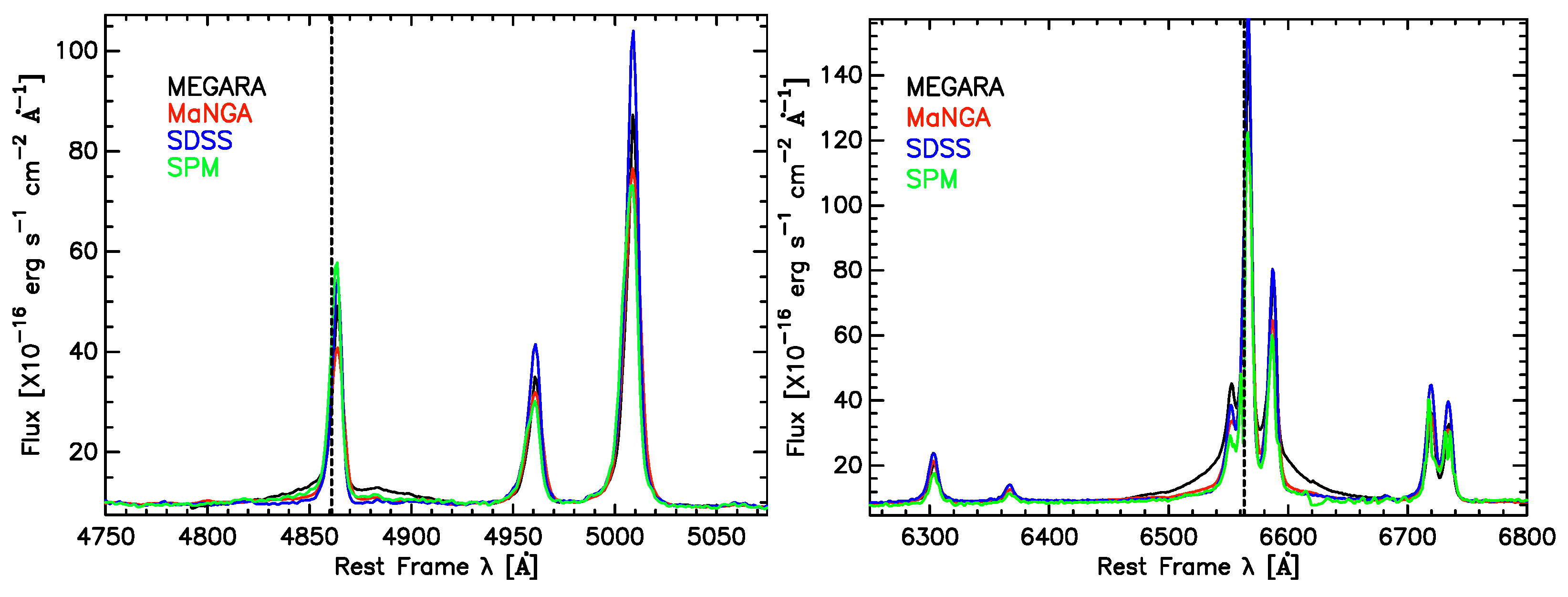
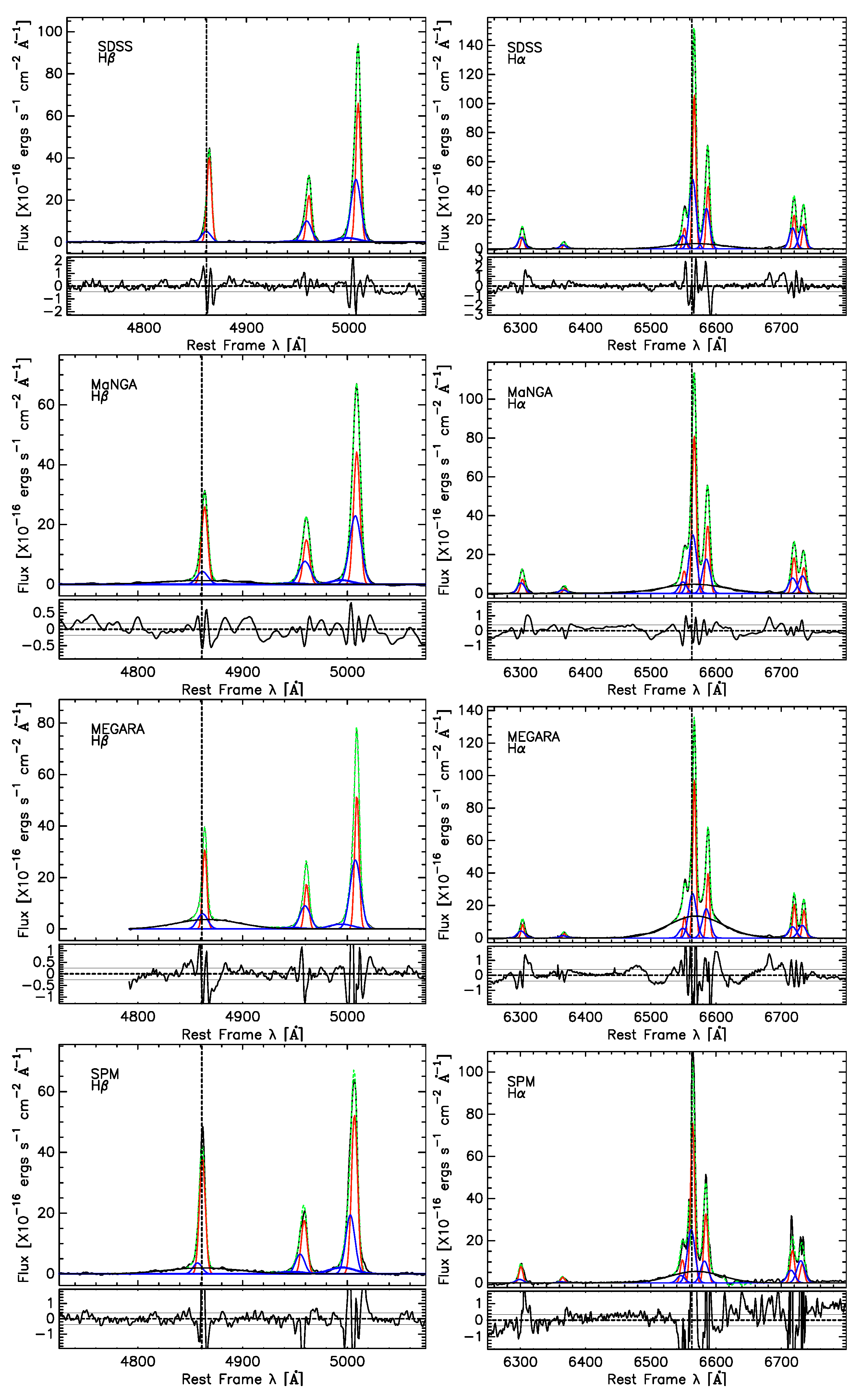
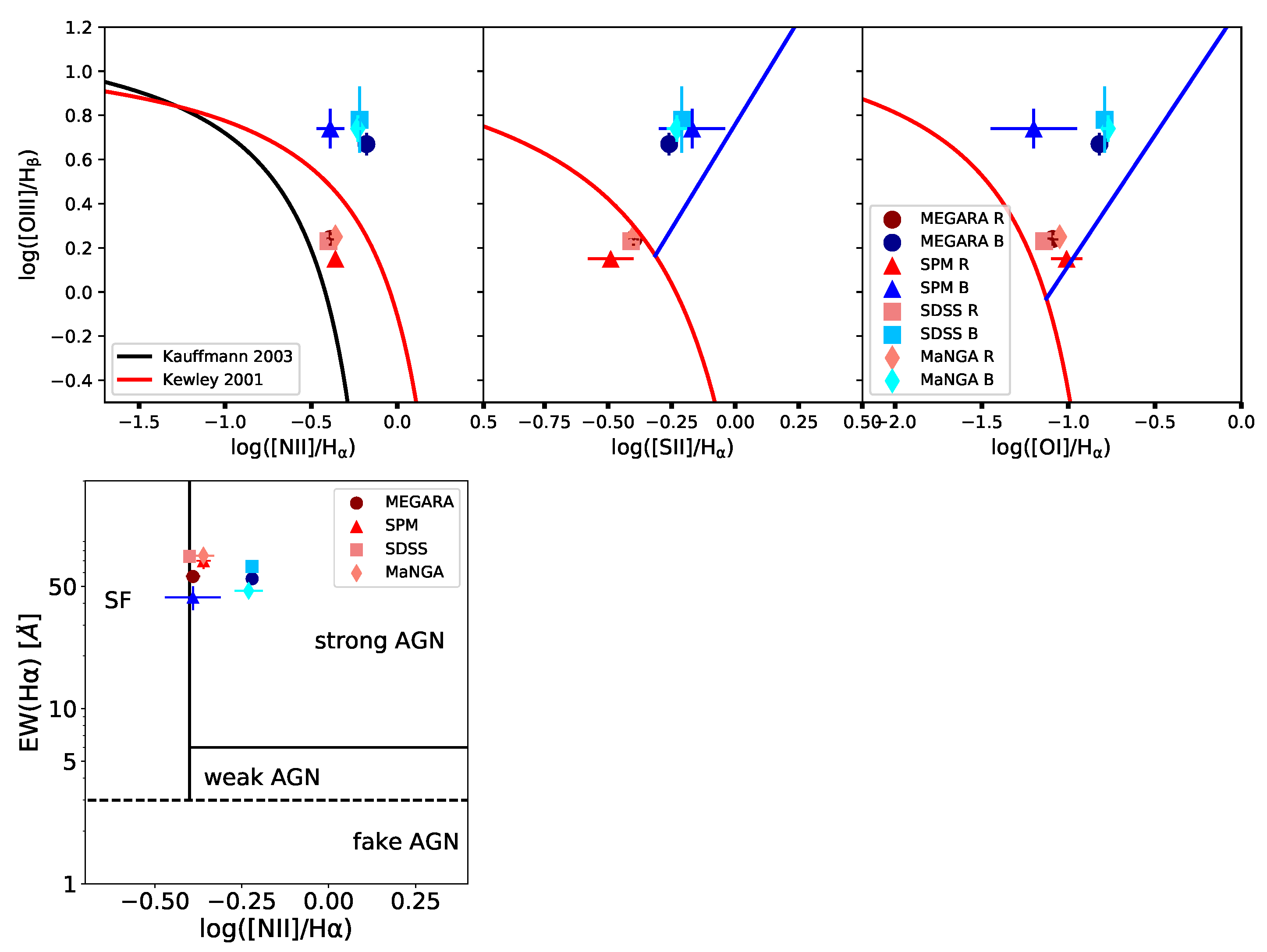
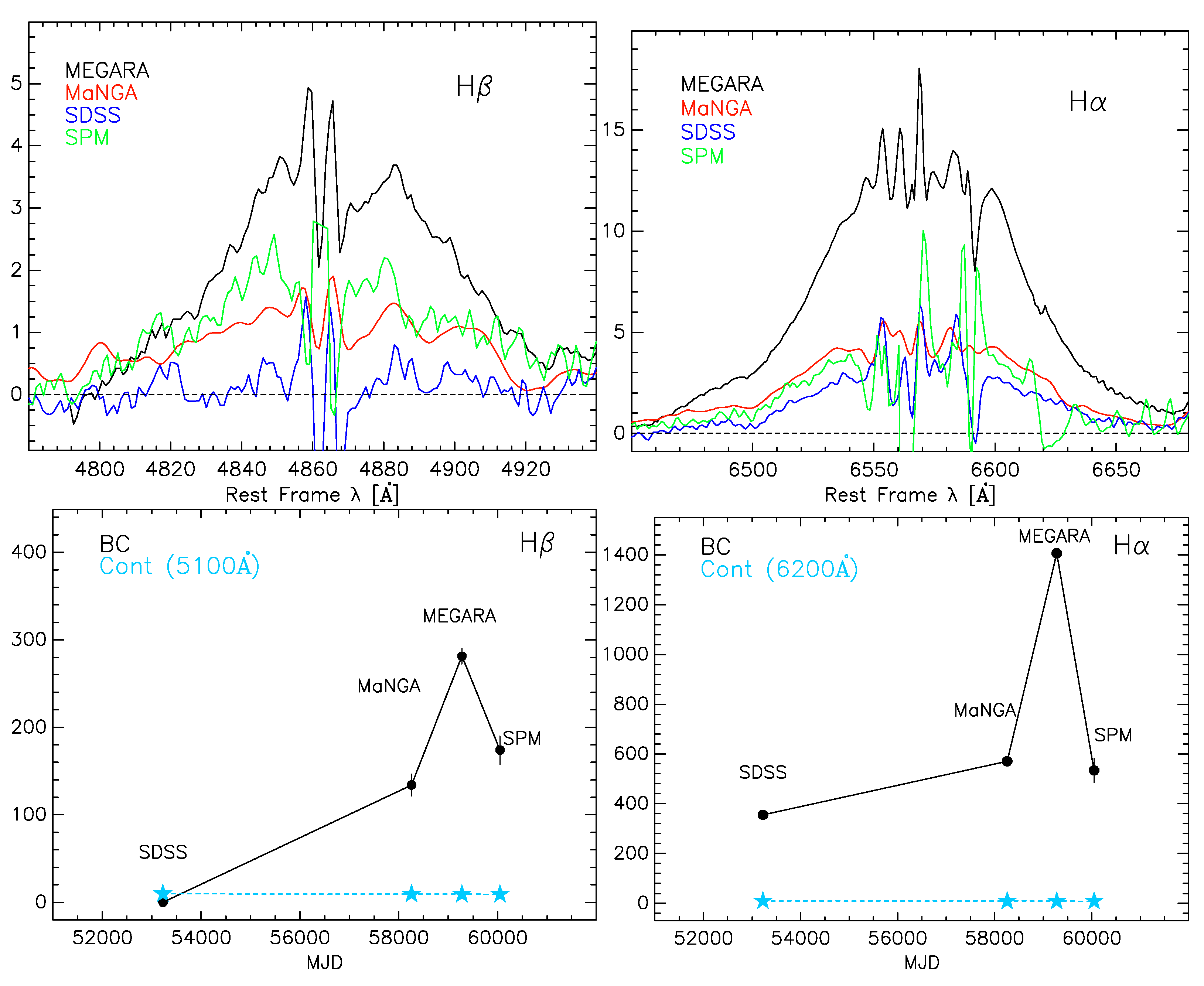
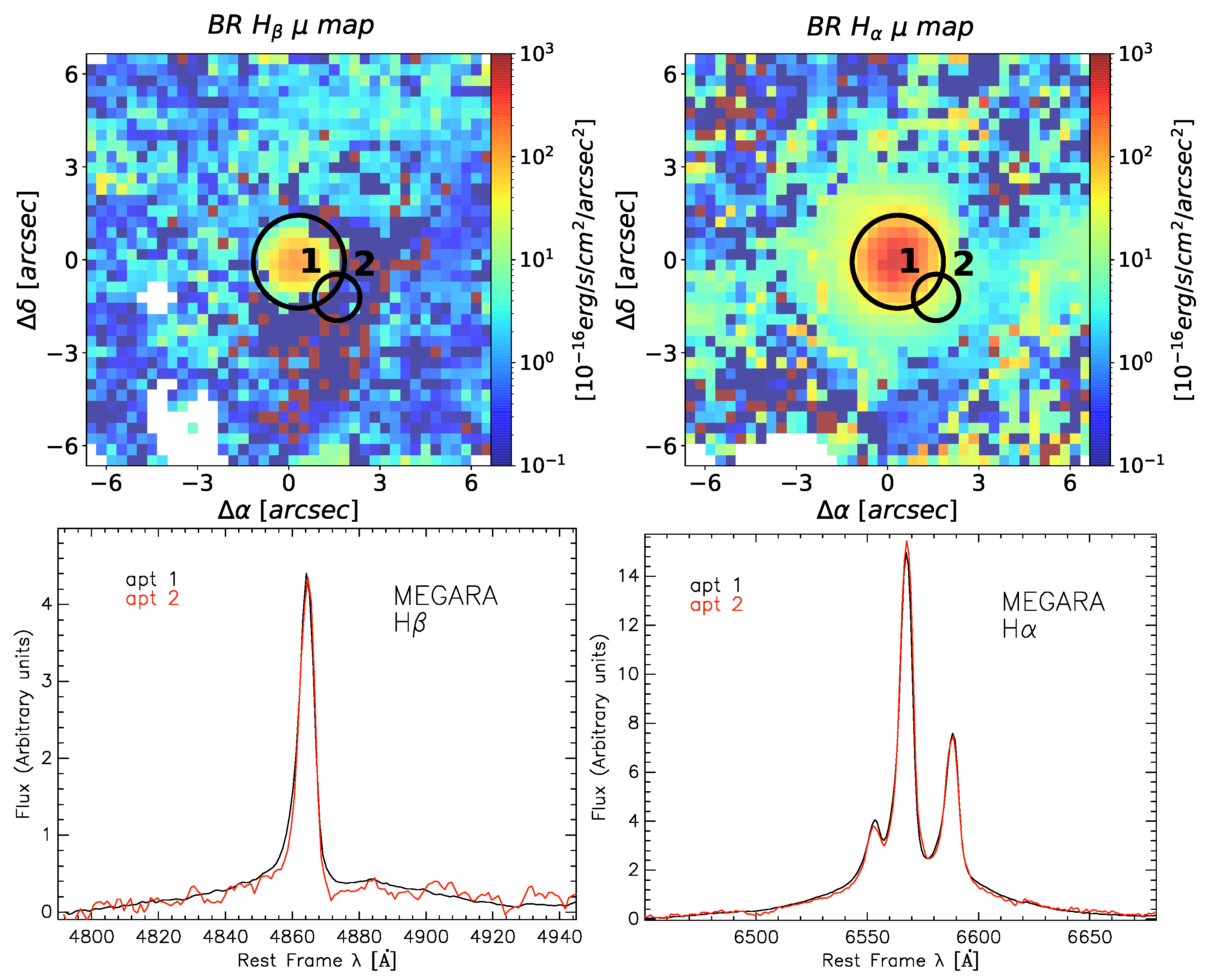
| Instrument | RA | DEC | Aperture Radius | Date | S/N |
|---|---|---|---|---|---|
| SDSS | 16:29:52.886 | +24:26:38.40 | 1.5 | 23 June 2003 | 41 |
| MaNGA | 16:29:52.886 | +24:26:38.40 | 1.5 | 18 May 2018 | 100 |
| MEGARA | 16:29:52.886 | +24:26:38.40 | 1.5 | 1 Jan 2021 | 71 |
| MEGARA | 16:29:52.794 | +24:26:37.25 | 0.75 | 1 Jan 2021 | 47 |
| SPM | 16:29:52.886 | +24:26:38.40 | 1.5 | 15 April 2023 | 47 |
| Line | SDSS | MaNGA | MEGARA | SPM |
|---|---|---|---|---|
| Flux | ||||
| H | 355.2 ± 10.7 | 570.7 ± 8.2 | 1406.4 ± 13.3 | 534.0 ± 29.6 |
| H B | 600.0 ± 6.0 | 446.4 ± 20.1 | 410.0 ± 7.8 | 370.1 ± 56.6 |
| H R | 671.6 ± 5.7 | 652.4 ± 20.1 | 594.6 ± 7.3 | 599.0 ± 11.4 |
| [Nii]6583 B | 350.0 ± 7.0 | 263.1 ± 10.5 | 268.6 ± 7.8 | 151.8 ± 20.4 |
| [Nii]6583 R | 272.2 ± 5.8 | 281.7 ± 10.1 | 243.5 ± 5.6 | 258.7 ± 8.5 |
| [Sii]6716 B | 183.9 ± 5.2 | 120.3 ± 6.4 | 106.2 ± 4.5 | 90.0 ± 13.4 |
| [Sii]6716 R | 150.1 ± 4.3 | 151.1 ± 5.6 | 129.2 ± 3.5 | 123.6 ± 12.5 |
| [Sii]6731 B | 194.3 ± 5.3 | 136.3 ± 5.9 | 119.8 ± 4.6 | 158.4 ± 15.2 |
| [Sii]6731 R | 109.1 ± 4.4 | 109.5 ± 5.5 | 107.3 ± 3.6 | 72.1 ± 17.0 |
| [Oi]6300 B | 94.3 ± 3.8 | 77.3 ± 4.1 | 62.1 ± 3.4 | 23.4 ± 10.0 |
| [Oi]6300 R | 49.7 ± 2.9 | 56.6 ± 3.6 | 48.5 ± 2.5 | 59.0 ± 7.1 |
| H | … | 134.2 ± 12.3 | 281.4 ± 8.8 | 174.1 ± 16.3 |
| H B | 59.5 ± 19.8 | 57.6 ± 5.6 | 73.3 ± 5.7 | 38.6 ± 6.5 |
| H R | 231.2 ± 4.9 | 193.3 ± 5.1 | 157.6 ± 4.9 | 270.0 ± 10.0 |
| [Oiii]5007 B | 357.2 ± 5.1 | 317.2 ± 12.1 | 340.0 ± 12.1 | 214.0 ± 10.0 |
| [Oiii]5007 R | 390.1 ± 0.8 | 340.3 ± 13.5 | 276.4 ± 13.3 | 380.0 ± 10.0 |
| [Oiii]5007 | 56.0 ± 19.8 | 36.8 ± 5.6 | 53.9 ± 5.7 | 66.0 ± 6.5 |
| FWHM | ||||
| H | 4336 ± 172 | 5181 ± 112 | 4473 ± 88 | 4199 ± 121 |
| H B | 538 ± 6 | 636 ± 11 | 642 ± 12 | 629 ± 92 |
| H R | 270 ± 2 | 345 ± 4 | 262 ± 2 | 338 ± 7 |
| H | … | 5927 ± 481 | 4353 ± 117 | 5076 ± 373 |
| H B | 672 ± 144 | 777 ± 78 | 712 ± 71 | 621 ± 25 |
| H R | 332 ± 21 | 431 ± 6 | 297 ± 6 | 408 ± 6 |
| [Oiii]5007 | 1586 ± 159 | 1425 ± 110 | 1599 ± 224 | 1758 ± 178 |
| EW | ||||
| H B | 64.49 ± 0.69 | 49.55 ± 1.20 | 45.30 ± 0.94 | 43.20 ± 6.67 |
| H R | 72.18 ± 0.66 | 72.41 ± 2.29 | 65.70 ± 0.88 | 69.92 ± 6.98 |
| Derived quantities | ||||
| logL | 44.23 ± 0.20 | 44.25 ± 0.19 | 44.26 ± 0.18 | 44.24 ± 0.20 |
| logM | 7.93 ± 0.20 | 8.07 ± 0.19 | 7.92 ± 0.20 | 7.80 ± 0.20 |
| logL | 46.03 ± 0.20 | 46.17 ± 0.19 | 46.03 ± 0.08 | 45.90 ± 0.20 |
| logL/L | 0.02 ± 0.01 | 0.01 ± 0.01 | 0.02 ± 0.01 | 0.02 ± 0.02 |
| Balmer decrement | … | 4.3 ± 0.5 | 5.0 ± 0.2 | 3.1 ± 0.5 |
Disclaimer/Publisher’s Note: The statements, opinions and data contained in all publications are solely those of the individual author(s) and contributor(s) and not of MDPI and/or the editor(s). MDPI and/or the editor(s) disclaim responsibility for any injury to people or property resulting from any ideas, methods, instructions or products referred to in the content. |
© 2024 by the authors. Licensee MDPI, Basel, Switzerland. This article is an open access article distributed under the terms and conditions of the Creative Commons Attribution (CC BY) license (https://creativecommons.org/licenses/by/4.0/).
Share and Cite
Benítez, E.; Negrete, C.A.; Ibarra-Medel, H.; Cruz-González, I.; Rodríguez-Espinosa, J.M. Multi-Epoch Optical Spectroscopy Variability of the Changing-Look AGN Mrk 883. Universe 2024, 10, 21. https://doi.org/10.3390/universe10010021
Benítez E, Negrete CA, Ibarra-Medel H, Cruz-González I, Rodríguez-Espinosa JM. Multi-Epoch Optical Spectroscopy Variability of the Changing-Look AGN Mrk 883. Universe. 2024; 10(1):21. https://doi.org/10.3390/universe10010021
Chicago/Turabian StyleBenítez, Erika, Castalia Alenka Negrete, Héctor Ibarra-Medel, Irene Cruz-González, and José Miguel Rodríguez-Espinosa. 2024. "Multi-Epoch Optical Spectroscopy Variability of the Changing-Look AGN Mrk 883" Universe 10, no. 1: 21. https://doi.org/10.3390/universe10010021
APA StyleBenítez, E., Negrete, C. A., Ibarra-Medel, H., Cruz-González, I., & Rodríguez-Espinosa, J. M. (2024). Multi-Epoch Optical Spectroscopy Variability of the Changing-Look AGN Mrk 883. Universe, 10(1), 21. https://doi.org/10.3390/universe10010021







